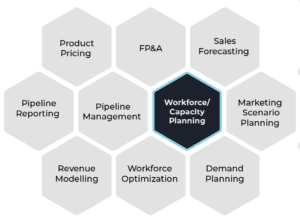- Business Transformation
- Sales & Revenue Optimization
- Finance & Operations
- Information Technology
- Private Equity
- Healthcare & Life Sciences
- High Tech
- Manufacturing
- Explore All Industries →
- Advisory + Diagnostics
- Change Management
- Implementation Services
- Cloud Application Managed Services
- Integrations
- Data Analytics
- Accelerators
- Cloud Applications
- Success Stories
- Insights + Events
- About Us
The aviation industry is renowned for its complexity and vulnerability to external factors. From fluctuating fuel prices to geopolitical tensions, airlines operate within a landscape of constant change. In 2023, the industry faced its fair share of challenges, with 22% flights experiencing delays in the US alone. These disruptions not only are an inconvenience to passengers but also have significant financial implications for airlines that affect their business objectives such as revenue, spending management, and more. To effectively manage these uncertainties and optimize their operations, airlines have turned to strategic scenario planning to help combat these obstacles.
Unlocking Opportunities with Strategic Scenario Planning on Uncharted Paths
Scenario planning is a forward-looking strategic technique that allows organizations to anticipate various possible future outcomes and accurately develop robust strategies to adhere to. In the context of the airline industry, scenario planning involves analyzing a wide range of variables, including fuel prices, passenger demand, regulatory changes, and geopolitical events. Through scenario analysis, airlines can better make informed decisions and develop contingency plans to adapt to unexpected trends.

One of the primary benefits of scenario planning in the airline industry is its ability to enhance resilience and agility. By anticipating potential disruptions and developing contingency plans, airlines can minimize the impact of unforeseen events and respond swiftly to changes in the operating environment.
Furthermore, scenario planning facilitates effective communication and collaboration within the organization. By involving stakeholders from across the organization, airlines can ensure alignment by ensuring that all stakeholders have access to and are working with the latest data, gaining buy-in for the proposed strategies and initiatives. Moreover, scenario planning enables airlines to communicate their vision and strategic direction more effectively to investors, regulators, and other external stakeholders, enhancing transparency and trust. Through scenario planning, a streamlined repository for data and analytics can be created, allowing stakeholders from across the organization to access up-to-date information and collaborate in real time. This real-time collaboration enables quicker and more informed decisions, reducing discrepancies. With offline tools, regular updates need to be set up, requiring additional manual effort. In the case of an emergency, this can delay decision making with outdated insights.
Scenario Planning’s Transformative Impact
In recent years, advancements in technology have revolutionized the way airlines approach scenario planning. Previously this was done by legacy systems and spreadsheets. Manually entering this data was time consuming and sometimes took days to be updated. Spreadsheets in particular often led to human error and inaccurate data.
However, the advent of sophisticated data analytics tools and predictive modeling techniques has enabled airlines to conduct more detailed and accurate scenario analyses, allowing them to make more informed decisions and optimize their operations more effectively. When this data is utilized in the right way, the airline industry can respond quickly to customer demand shifts, reduce operating costs, increase employee satisfaction, optimize their workforce planning, reduce overhead, and maximize flight capacity. This helps them increase their revenue, leverage growth opportunities, predict the market, and stand out from their competitors.

What Does the Future Hold?
The integration of artificial intelligence (AI) and machine learning (ML) algorithms into scenario planning processes has enabled airlines to automate repetitive tasks, analyze vast amounts of data efficiently, and generate actionable insights in real-time. This integration is seen in Spaulding Ridge’s Workforce Planning solution. The solution leverages the power of internal customer relationship management (CRM) and data solutions’ timely insights with Anaplan on annual flight plan adjustments by base, seat, and aircraft. By having streamlined reports that provide timely visibility into the impact on the profit and loss, airlines can quickly adjust vacation buyback policies, base transfer requests, and reserve percentages. Pulling this data into Anaplan allows for dynamic statistical modelling of staffing needs and summarizes the impact of each scenario through version comparison.
Version comparison enables companies to assess the financial and operational effects of adjusting levers and key metrics. Airlines could adjust the percentage of reserve pilots, observing the ripple effect on vacation hours, pilot recruitment, training, and benefits. Alternatively, they could expand flight capacity by 300 block hours, analyzing the impact on revenue, fuel consumption, flight scheduling, staffing adjustments, and route optimization. This strategic analysis empowers informed decision-making, optimizing resource allocation and enhancing overall performance.
By anticipating potential disruptions, optimizing resource allocation, and making better informed decisions, airlines can accurately drive sustainable growth to hit business targets, while eliminating tedious manual processes. Spaulding Ridge offers tailored scenario planning designed to align seamlessly with your unique business processes. Amidst uncertain landscapes, safeguard the future of your business by exploring strategic case scenarios. To ensure your business is equipped for what lies ahead, reach out to us.








